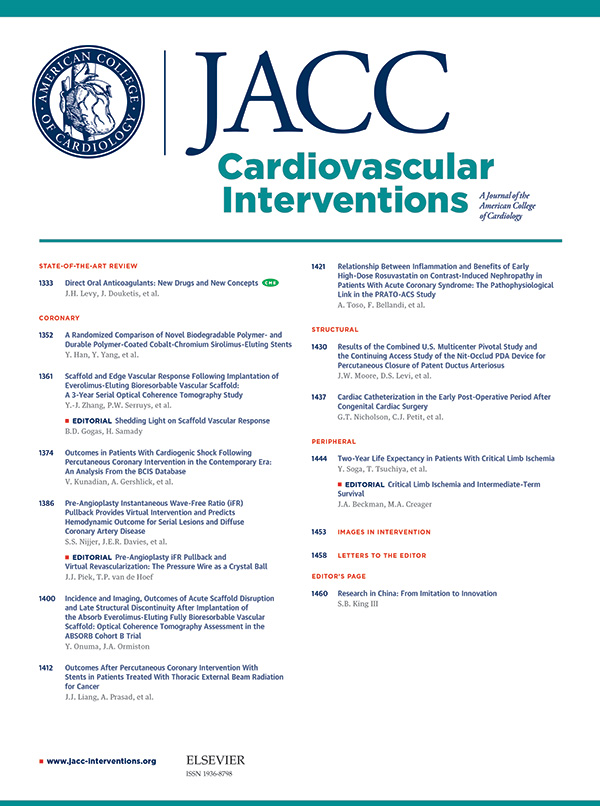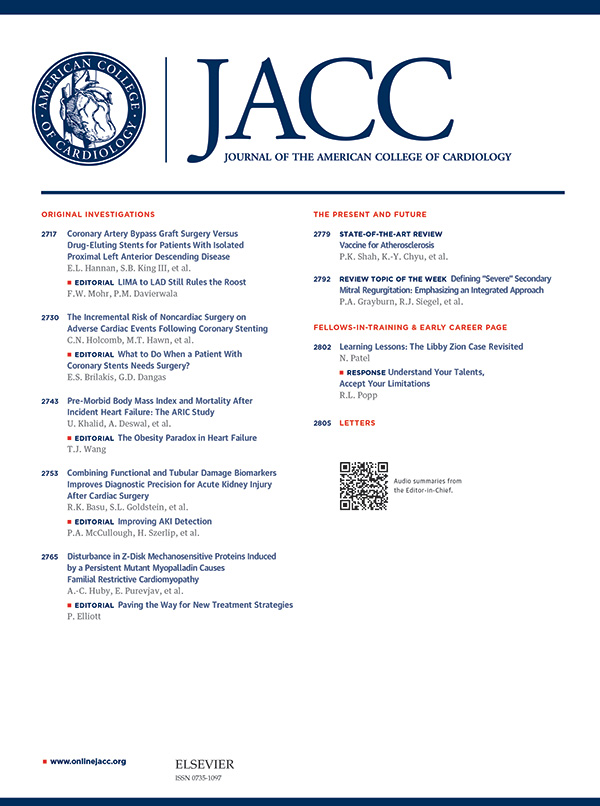JACC in a Flash
Featured topics and Editors' Picks from all of ACC's JACC Journals.
LEVANT: Femoropopliteal DCB Not Linked to Mortality Increase

A review of data from recent randomized controlled trials concludes there is no significant statistical difference in long-term mortality between patients treated for femoropopliteal peripheral artery disease (PAD) with drug-coated balloons (DCBs) and stents vs. uncoated balloon angioplasty (PTA). The research was presented at TCT 2019 and published in JACC: Cardiovascular Interventions.
Kenneth Ouriel, MD, et al., reviewed data from the LEVANT 1, LEVANT 2 and LEVANT Japan trials after a recent meta-analysis based on data from heterogenous trials and summary-level data found increased mortality among patients treated with paclitaxel-coated balloons and stents.
Researchers evaluated 1,093 DCB and 250 PTAs. Based on the aggregate dataset from the LEVANT trials using patient-level data, the hazard ratio (HR) for mortality was 1.01 at five years. There was no clustering of causes of death or adverse events within any category and no dose-response relationships. The studies are a subset of 3,095 patients treated for femoropopliteal PAD with the Lutronix DCB or with uncoated balloon angioplasty.
Survival rates were higher in patients who underwent paclitaxel or non-paclitaxel reinterventions vs. those who did not. Baseline factors that predicted mortality, with no differences between treatment arms, included age (HR, 1.03/year; p<0.0001), prior treatment of target lesion (HR,1.67; p=0.022), arrhythmia (HR, 1.65; p=0.031) and diabetes (HR, 1.18; p=0.047).
The review of the data can be used to evaluate Lutronix DCBs and form a basis for the design of future studies of paclitaxel devices as well as other lower extremity interventional devices, wrote the study authors.
Ouriel K, Adelman MA, Rosenfield K, et al. JACC Cardiovasc Interv 2019;Sept 28:[Epub ahead of print].
CENTER Collaboration: Bleeding a Greater Threat to Women Than Men After TAVR

Following transfemoral transcatheter aortic valve replacement (TAVR), women and men have similar rates of 30-day mortality and stroke, but women have a 50 percent greater risk of life-threatening or major bleeding, according to results of an analysis presented at TCT 2019 and simultaneously published in the Journal of the American College of Cardiology.
Wieneke Vlastra, MD, et al., used a global patient-level dataset from the CENTER collaboration, examining 12,381 patients (7,120 women; 58 percent) undergoing transfemoral TAVR from 2007 to 2018. Researchers examined differences between women and men in baseline patient characteristics, 30-day stroke and mortality, and in-hospital outcomes. They also assessed temporal changes in outcomes and predictors for mortality by sex.
The retrospective analysis showed that women compared with men had a higher prevalence of hypertension (81 percent vs. 76 percent) and renal failure (14 percent vs. 11 percent) but a lower prevalence of all other traditional cardiovascular comorbidities (33 percent vs. 51 percent). Both women and men had similar rates of 30-day stroke (2.3 percent vs. 2.5 percent) and all-cause mortality (5.9 percent vs. 5.5 percent).
The risk of life-threatening or major bleeding was 6.7 percent in women compared with 4.4 percent in men (p<0.001) after TAVR. An inverse relationship between body mass index and the risk of bleeding was found in women, but not in men, with a risk of 7.7 percent in the lowest tertile and 5.5 percent in the highest tertile.
"The current study does not support the hypothesis that female gender is a risk factor for TAVR-related mortality," write the researchers. "Females had [a] 50 percent higher risk of life-threatening or major bleeding." They note that one of the most important risk factors for bleeding is a large sheath-to-femoral artery ratio, accordingly the smaller iliofemoral arteries and vascular tortuosity in females most likely contribute to the increased risk of vascular complications and consequently bleeding. "Bleeding risk was more pronounced in females with low BMI [and] we hypothesize [that] smaller females have smaller vessels than larger females and consequently have a higher risk of vascular complications and bleedings."
Vlastra W, Chandrasekhar J, García Del Blanco B, et al. J Am Coll Cardiol 2019;Sept. 25:[Epub ahead of print].
RA vs. OA in Treating Severe Coronary Artery Calcification in PCI Patients

A retrospective cohort study comparing safety and effectiveness of rotational atherectomy (RA) or orbital atherectomy (OA) in treating severe coronary artery calcification in patients undergoing PCI found similar rates of procedural success. The findings were presented at TCT 2019 and published in JACC: Cardiovascular Interventions.
Devika Aggarwal, MBBS, et al., analyzed data from 135,243 consecutive PCIs performed between January 2014 and March 2018 at 48 hospitals participating in the Blue Cross Blue Shield of Michigan Cardiovascular Consortium. An atherectomy device was used in 2,994 (2.21 percent) cases, with OA used in 1,033 and RA used in 1,801. Optimal full propensity matching and stratified logistic regression was used to evaluate the impact of atherectomy device choice on outcomes adjusting for patient characteristics. Procedural success was defined as residual stenosis ≤30 percent and perfect procedural success was defined as residual stenosis ≤10 percent.
OA and RA were associated with similar rates of both procedural success (94.2 percent vs. 94.6 percent, respectively) and perfect procedural success (88.6 percent vs. 89.8 percent, respectively). Researchers observed no differences between the two groups in the incidence of perforation, NCDR defined bleeding, major bleeding, stent thrombosis, persistent no reflow, emergency or salvage CABG, and all cause death.
Additionally, data showed a significant increase in both RA and OA use over the study period, with RA or OA used at least once by 249 operators (68.2 percent). However, researchers noted that OA use increased more rapidly. Operators who used OA also were found to use RA, while a substantial number of operators only used RA.
The researchers write, "the overall similar outcomes suggest that the operators' use of their preferred device was associated with similar outcomes irrespective of the specific atherectomy treatment modality. With similar safety and effectiveness profiles, either OA or RA can be used in the treatment of increasingly prevalent severe coronary artery calcification."
Aggarwal D, Seth M, Perdoncin E, et al. JACC Cardiovasc Interv 2019;Sept 25:[Epub ahead of print].
Is TMVR Safer Due to Technological Advancements, Increased Operator Experience?

Do technological advancements and increasing operator experiences make transcatheter mitral valve repair (TMVR) safer for patients with severe symptomatic degenerative mitral regurgitation at prohibitive risk of surgery? The overall answer may be yes, according to new research presented at TCT 2019 and published in JACC: Cardiovascular Interventions.
Researchers, led by Michael J. Hendrickson, identified hospitalizations from the Healthcare Cost and Utilization Project and National Readmission Database (NRD) between January 2012 and November 2016 in which patients were undergoing elective TMVR (3,269/18 percent) or surgical mitral valve repair (SMVR) (14,819/82 percent). They then assessed linear temporal trends in patient outcomes and heart failure (HF) readmissions post TMVR vs. SMVR.
Overall results found the proportion of TMVR procedures substantially increased from 5 percent in 2012 to 58 percent in 2016, with TMVR patients more likely to be older and male. Additionally, the incidence of adverse events, including inpatient mortality, blood transfusion and HF readmissions decreased for TMVR patients during the period. The composite endpoint of inpatient stroke, inpatient mortality and 30-day HF readmissions also decreased (8.0 percent to 5.6 percent). Researchers noted the incidence of inpatient ischemic stroke remained relatively stable.
For SMVR patients, there were no significant differences in age and sex of patients. Researchers also saw an increase in inpatient mortality, HF readmissions and inpatient ischemic stroke between 2012 and 2016. The composite endpoint following SMVR also increased from 4.7 percent to 6.3 percent. A decrease in the incidence of blood transfusions, however, was observed.
"Overall, TMVR seems to have become safer over time," researchers said. However, they suggest additional research is needed to further confirm their findings.
Hendrickson MJ, Bhyan P, Arora S, et al. JACC Cardiovasc Interv 2019;Sept 25:[Epub ahead of print].
Long-Term Durability of Transcatheter Heart Valves Explored

Researchers assessing the long-term durability of nominally deployed transcatheter heart valves (THV) to an equivalent of 25 years of wear, and non-nominal (overexpansion, underexpansion and elliptical) THV deployments equivalent to five years of wear, found "excellent durability" in both cases. These findings were presented at TCT 2019 and simultaneously published in JACC: Cardiovascular Interventions.
The study compared SAPIEN 3 THVs (sized 20 mm, 23 mm, 26 mm and 29 mm) with Magna Ease surgical valves. Accelerated wear testing (AWT) to one billion cycles (equivalent of 25 years) was used to assess nominally deployed THVs, while AWT to 200 million cycles (equivalent of five years) was used to test durability of non-nominal THV deployments.
Results from the nominally deployed THV assessment found that at 1 billion cycles the regurgitant fraction for the 20 mm, 23 mm, 26 mm and 29 mm SAPIEN 3 was 0.92±0.47 percent, 1.29±0.04 percent, 1.73±0.46 percent and 2.47±0.15 percent, respectively, which was similar to the comparator surgical valves tested. Similarly, the regurgitant fraction of non-nominal over-expanded, under-expanded and elliptical THVs "were excellent at 200 million cycles," researchers said.
"This bench study demonstrates that the nominally deployed S3 THV has excellent long-term durability, as assessed by AWT, to an equivalent of 25 years (1 billion cycles)," write Janarthanan Sathananthan, MBChB, MPH, and colleagues. "…Non-nominal THV deployments also had excellent durability to an equivalent of 5 years wear, with similar performance to nominally deployed THVs. In younger patients with longevity, durability is an important consideration when determining valve choice." Further clinical studies are needed to understand long-term durability in THVs, particularly in younger patient populations.
Sathananthan J, Hensey M, Landes U, et al. JACC Cardiovasc Interv 2019;Sept 25:[Epub ahead of print].
Study Compares Frequency of PPM With SEV vs. BEV

Self-expandable valves (SEV) were associated with a lower frequency of prosthesis-patient mismatch (PPM) compared with balloon-expandable valves (BEV), according to research presented during TCT 2019 and published in JACC: Cardiovascular Interventions. Researchers led by Taishi Okuno, MD, said the difference was primarily driven by obese patients.
The study compared a total of 757 patients treated with SEV and BEV between August 2007 and June 2017. Researchers classified PPM based on discharge prosthetic effective orifice area indexed to BSA as severe (<0.65 cm2/m2) or moderate (0.65 to 0.85 cm2/m2) in the general population, and as severe (<0.60 cm2/m2) or moderate (0.60 to 0.90 cm2/m2) in the obese population (BMI ≥30 kg/m2).
Overall results showed SEV were associated with a lower incidence of PPM (PPM: 33.5 percent vs. 46.9 percent; severe PPM: 6.7 percent vs. 15.6 percent). Researchers highlighted the significant difference between SEV and BEV in patients with BSA >1.83 m2. The also noted that "SEV had a preventative effect on PPM as compared to BEV in general and even in patients with relatively larger annulus size."
While there was no significant difference in patients with BSA ≤1.83 m2, as well as no impact of PPM on cardiovascular mortality or NYHA functional class at one year, researchers recommend further investigation "to evaluate the clinical significance of PPM."
In a related editorial comment, Howard C. Herrmann, MD, FACC, calls the findings "encouraging" and notes "the strength of this analysis is the use of propensity matching to balance baseline characteristics between the groups," resulting in inclusion of 224 matched pairs. "Awareness and prediction of the risk of severe PPM after TAVR is a key first step," he writes. "As new and additional TAVR prostheses become available, utilization of the one with the largest suitable effective valve orifice area for a patient at risk for PPM should become an important point for discussion in our heart team meetings."
Okuno T, Khan F, Asami M, et al. JACC Cardiovasc Interv 2019;Sept 25:[Epub ahead of print].
Is a Higher Post PCI QFR Associated With Improved Vessel-Related Clinical Outcomes?

A higher post PCI quantitative flow ratio (QFR) value is associated with improved vessel-related clinical outcomes in state-of-the art PCI practice for de novo three vessel disease (3VD), according to new findings presented at TCT 2019 and published in JACC: Cardiovascular Interventions. "Achieving a post PCI QFR value ≥0.91 in all treated vessels should be a target when treating de novo 3VD," note Norihiro Kogame, MD, and colleagues.
The study, a subanalysis of the SYNTAX II trial, retrospectively computed post PCI QFR at vessel level. The vessel-oriented composite endpoints (VOCE) was a composite of vessel-related cardiac death, vessel-related myocardial infarction and target vessel revascularization.
Results at two years showed VOCE occurred in 52 cases (6.7 percent). "The diagnostic performance of post PCI QFR to predict two-year VOCE was moderate," researchers said. They also noted the incidence of two-year VOCE in the vessels with post PCI QFR <0.91 was significantly higher compared with vessels with a post PCI QFR ≥0.91.
According to Kogame, et al., additional main findings include the fact that post PCI QFR was analyzable in 79.6 percent of treated vessels without specific acquisition guideline in patients with de novo 3VD. Previous myocardial infarction, serial lesions, LAD stenosis, lower preprocedural QFR value and lower MSA derived from IVUS were also associated with a lower post PCI QFR value in patients with de novo 3VD.
The researchers recommend prospectively investigating "the relationship between post PCI QFR and clinical outcomes … in future trials with online computation according to specific acquisition guidelines."
In a related editorial comment, Abdul Hakeem, MD, and Barry F Uretsky, MD, write that "using QFR as part of an ideal PCI algorithm may be part of the solution to equalizing long-term outcomes of PCI with bypass surgery (functionally complete revascularization), particularly if it is shown in a randomized trial that use of functional evaluation post PCI (with any measure) is superior to pre PCI functional evaluation alone."
Kogame N, Takahashi K, Tomaniak M, et al. JACC Cardiovasc Interv 2019;Sept 25[Epub ahead of print].
Clinical Topics: Arrhythmias and Clinical EP, Cardiac Surgery, Cardiovascular Care Team, Heart Failure and Cardiomyopathies, Invasive Cardiovascular Angiography and Intervention, Prevention, Valvular Heart Disease, Atherosclerotic Disease (CAD/PAD), Implantable Devices, SCD/Ventricular Arrhythmias, Atrial Fibrillation/Supraventricular Arrhythmias, Aortic Surgery, Cardiac Surgery and Arrhythmias, Cardiac Surgery and Heart Failure, Cardiac Surgery and VHD, Acute Heart Failure, Interventions and Coronary Artery Disease, Interventions and Structural Heart Disease, Interventions and Vascular Medicine, Hypertension, Mitral Regurgitation
Keywords: ACC Publications, Cardiology Magazine, Algorithms, Angioplasty, Balloon, Arrhythmias, Cardiac, Atherectomy, Atherectomy, Coronary, Blood Transfusion, Blue Cross Blue Shield Insurance Plans, Body Mass Index, Brain Ischemia, Cause of Death, Comorbidity, Constriction, Pathologic, Coronary Artery Disease, Coronary Vessels, Diabetes Mellitus, Femoral Artery, Health Care Costs, Heart Failure, Hemorrhage, Hypertension, Heart Valves, Incidence, Inpatients, Logistic Models, Lower Extremity, Mitral Valve, Mitral Valve Insufficiency, Longevity, Myocardial Infarction, Obesity, Paclitaxel, Percutaneous Coronary Intervention, Patient Readmission, Peripheral Arterial Disease, Prevalence, Prostheses and Implants, Renal Insufficiency, Retrospective Studies, Stroke, Surgical Instruments, Survival Rate, Risk Factors, Stents, Thrombosis, Transcatheter Aortic Valve Replacement
< Back to Listings


